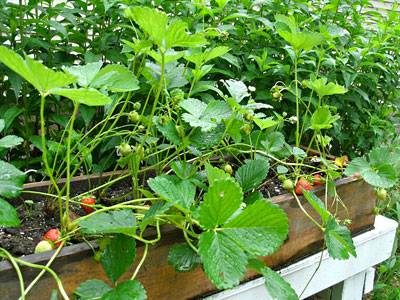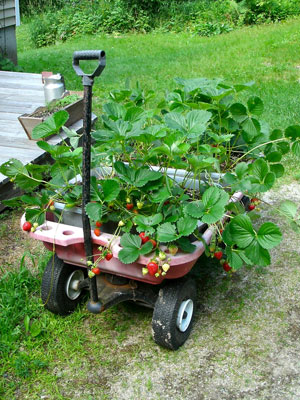 |
| An order of strawberries that was 10-times what the author ordered populated the neighborhood and family gardens – even container gardens – with the luscious plants. Photo by Joyce White. |
By Joyce White
From the time I was 10, the first sunny days of summer vacation would find me walking purposefully past placid Holsteins munching dandelion-studded grass. (In Canaan when I grew up in the 1930s, we had the freedom – when we weren’t working – to wander the fields and woods at will.) I would set out full of high spirits and expectation, with an empty pan and Tinker, the family dog, across pasture and brook, until I entered the stretch of woods that opened into an abandoned field where wild strawberries ripened first. And then, my idea of heaven: ripe strawberries lying in a jeweled carpet shining in the sun through the sparse grass of the untended field.
Nothing is more delicious than wild strawberries (Fragaria virginiana) with a little cream and maple syrup. But it’s not only the taste of these little gems that has a hold on my psyche; just as important is finding this gift of Nature, free for the taking, and of picking them in a quiet, fragrant field with only the sounds of nature – an oasis of peace.
First Berries
Where did these fruits come from? In one version of Cherokee legend, at www.firstpeople.us/, Barbara Shining Woman Warren retells “The Origin of Strawberries.” A First Couple had argued and the woman left in anger, walking eastward. Later, the man followed her path. Sun looked down on the man with pity and asked if he was still angry. When he said his anger had passed, Sun found the woman still heading east, and in repeated efforts to entice her to stop, made various fruits grow in her path, but she ignored them – until she came upon the strawberries, which “had never grown on the earth before,” related Warren. The woman picked one. “Hmmm – she had never tasted anything quite like it! It was so sweet.” As she ate berries, her anger faded. She gathered all the berries she could carry and headed home. She met First Man on the way and they shared the berries and walked home hand in hand.
Even today, says Warren, strawberries are often kept in Cherokee homes as a reminder not to argue and as a symbol of good luck.
Maine’s wild strawberry fields are becoming scarce as farmland is sold to developers to create second homes. Everywhere I’ve lived in Maine, I’ve been able to find a place to pick wild strawberries, until five years ago, when a developer bought the old farm where strawberries grew near my western Maine home.
 |
| Photo by Joyce White. |
Home-Grown Fills the Gap
Change happens whether I like it or not, so, although I continue to seek wild strawberry fields wherever I live, I have grown cultivated varieties for many years.
I especially like the everbearing or day-neutral varieties that produce fat, ripe strawberries all summer and until frost arrives. For several years 25 plants have supplied my daily quota for fresh eating from June to October. For a larger supply for the freezer and jam pot, I visit U-Pick farms for June-bearing varieties.
To grow my crop, I first created a raised bed with stones against an existing stone wall – neglecting to consider the family of chipmunks living in that wall. I didn’t mind sharing some of the bounty, and seeing a chipmunk perched jauntily atop the stones, munching a fat red strawberry held between his dainty paws, was almost endearing. They didn’t eat many – until two summers ago when, for some reason, the chipmunk population exploded. Nobody in this section of western Maine got strawberries or blueberries that year; chipmunks got them all.
I’ll never relinquish my strawberry addiction nor my gardeners’ optimism that “this year will be different,” so I ordered 50 ‘Seascape’ plants – 25 for me and 25 for my daughter-in-law – from Hartmann’s Nursery. I hadn’t grown this day-neutral variety before; it’s described as “incredibly juicy, flavorful and aromatic,” disease resistant and suitable for container growing.
To create a new bed in a chipmunk-free zone, I filled two plastic storage bins, each 18 inches by 15 inches by 5 inches, with existing drainage holes, and one long wooden planter, 34 inches by 12 inches by 7 inches, with a mix of 1 part moistened soil-less planting mix, 1 part leaf-mold from the woods and 1/2 part bagged cow manure.
When the plants arrived in a big box, I took one of the bundles lying on green cardboard in the box and began planting them about 6 inches apart with crowns at soil level, clipping the longest roots before tucking them into slots made with a trowel. After I had filled the containers, I put the rest of that bundle in three plastic pots, each about 11 inches deep and 11 inches in diameter. I had set 54 plants and there was still another big bundle.
While examining the second bundle, I was astonished to find a second layer beneath the green cardboard, packed with numerous more bundles of strawberry plants! When I called Hartmann’s I was told, “Oh, they must have sent 500 instead of 50.” And no, he didn’t want them back; give them away, he said.
So I planted three more large pots for the back deck and then began contacting friends and neighbors. I planted some for elderly neighbors and gave instructions to people who came to get plants and had never grown strawberries before. And of course friends and neighbors who came for plants stopped to chat; all those strawberries and visitors were taking a lot of time!
I drove to Yarmouth and helped my daughter-in-law and grandson plant as many as they could manage, and made more calls and emails. Finally, four days after their arrival, all 500 plants had homes. ‘Seascape’ strawberries now populate our small town and beyond.
Those plants began blossoming in June, and from July until hard frost in mid-October, I had ripe berries daily. Chipmunks found them on the low bench directly in front of the deck, so I moved those containers to higher places. All the plants did well, but fruits in the tall plastic pots rotted a lot more during some long wet periods than those in the low wooden containers. In late August green stink bugs that I had never seen before – shield-shaped with fine striping and about the size of Japanese beetles – found my plants. They are pictured here: www.maine.gov/agriculture/pesticides/gotpests/bugs/stink-bug.htm. [Ed. note: Many beneficial insects prey on stink bugs, and row covers can exclude them.]
Late fall berries, though red, lacked the juicy flavor of summer berries. For overwintering, Hartmann’s suggested keeping the plants moist until fully dormant, leaving foliage on them and either leaving them outside or in an unheated space with a light mulch. Mine are in the garage, some with pine needle mulch, some draped with an old towel and some without mulch. Maybe I’ll know by May which worked best.
About the author: Joyce thrives on her edible landscape in Stoneham, Maine.
For more on growing strawberries, see “Strawberry Production Systems” in the March-May 2012 issue of The MOF&G.

